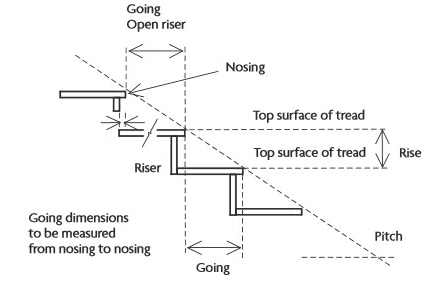Step
NB For project stages (or steps) see: Comparison of standard project plans used in the construction industry.
In general, the word ‘step’ refers to the individual parts of a staircase that people step on. This is as opposed to ‘stairs’ which are a flight of steps.
Steps can be constructed using a wide variety of materials, including; timber, brick, stone, concrete, metal, glass, and so on.
Individual steps are made up of a horizontal tread and a vertical riser. They are measured in terms of a ‘going’, i.e. the depth from front-to-back of the step (less any overlap with the next step above), a rise (the vertical distance between treads, and the width from one side to the other.
Steps should have level treads with the rise and going of each step consistent throughout the flight. The part of the tread that sometimes overhangs the riser is called the ‘nosing’. Depending on the design, the riser can be left open, or can be closed.
Some types of stairs (e.g. circular, spiral) can incorporate winders, which are steps that have one side narrower than the other. This allows the stairs direction to change without a landing.
The requirements for the design of steps are set out in the approved documents to the building regulations:
- Approved document K: Protection from falling, collision and impact.
- Approved document M: Access to and use of buildings (only when external stepped access also forms part of the principal entrances and alternative accessible entrances and when they form part of the access route to the building from the boundary of the site and car parking).
- Approved document B: Fire safety.
For more information, see Stair design.
[edit] Related articles on Designing Buildings
Featured articles and news
The UK's Modern Industrial Strategy: A 10 year plan
Previous consultation criticism, current key elements and general support with some persisting reservations.
Building Safety Regulator reforms
New roles, new staff and a new fast track service pave the way for a single construction regulator.
Architectural Technologist CPDs and Communications
CIAT CPD… and how you can do it!
Cooling centres and cool spaces
Managing extreme heat in cities by directing the public to places for heat stress relief and water sources.
Winter gardens: A brief history and warm variations
Extending the season with glass in different forms and terms.
Restoring Great Yarmouth's Winter Gardens
Transforming one of the least sustainable constructions imaginable.
Construction Skills Mission Board launch sector drive
Newly formed government and industry collaboration set strategy for recruiting an additional 100,000 construction workers a year.
New Architects Code comes into effect in September 2025
ARB Architects Code of Conduct and Practice available with ongoing consultation regarding guidance.
Welsh Skills Body (Medr) launches ambitious plan
The new skills body brings together funding and regulation of tertiary education and research for the devolved nation.
Paul Gandy FCIOB announced as next CIOB President
Former Tilbury Douglas CEO takes helm.
UK Infrastructure: A 10 Year Strategy. In brief with reactions
With the National Infrastructure and Service Transformation Authority (NISTA).
Ebenezer Howard: inventor of the garden city. Book review.
The Grenfell Tower fire, eight years on
A time to pause and reflect as Dubai tower block fire reported just before anniversary.
Airtightness Topic Guide BSRIA TG 27/2025
Explaining the basics of airtightness, what it is, why it's important, when it's required and how it's carried out.
Construction contract awards hit lowest point of 2025
Plummeting for second consecutive month, intensifying concerns for housing and infrastructure goals.
Understanding Mental Health in the Built Environment 2025
Examining the state of mental health in construction, shedding light on levels of stress, anxiety and depression.
The benefits of engaging with insulation manufacturers
When considering ground floor constructions.
Lighting Industry endorses Blueprint for Electrification
The Lighting Industry Association fully supports the ECA Blueprint as a timely, urgent call to action.

























